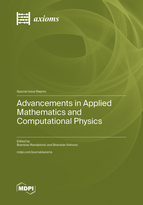Advancements in Applied Mathematics and Computational Physics
A special issue of Axioms (ISSN 2075-1680). This special issue belongs to the section "Mathematical Physics".
Deadline for manuscript submissions: closed (31 July 2025) | Viewed by 16892
Special Issue Editors
Interests: applied mathematics; graph theory; fractals; neural networks; AHP fuzzy algebra; geometry; numerical mathematics; material science; mathematical education methodology; education
Special Issues, Collections and Topics in MDPI journals
Interests: genomics and mathematics,experimental and theoretical nuclear and hypernuclear physics; material science; nanotechnology; photonics and photovoltaics; chemistry; cosmology
Special Issues, Collections and Topics in MDPI journals
Special Issue Information
Dear Colleagues,
Mathematics and physics, as basic natural sciences, are the root of almost all processes in nature and technology. There are a large number of situations where those two sciences can offer the best models and most appropriate explanations for natural processes or technological problems.
The aim of this Special Issue is to present various ways and new solutions to explain the nature of matter, biophysical systems and systems in technical sciences in the frame of overall reality, using the latest achievements in applied mathematics and computational physics.
The focus of this Special Issue is on new results and solutions in contemporary applied mathematics, algebra, mathematical logic, graph theory, fractals, chaos theory, numerical mathematics, mathematical physics and the latest results in experimental physics, computational physics and physical electronics for problems in nature, technology, technics and electronics.
This Special Issue will cover a broad range of topics to provide new insight into the exploration of the world of electronics, physical electronics, nuclear and hyper-nuclear physics, nanotechnology, material science, photonics and photovoltaics, cosmology, genomics and nature.
The content of this Special Issue will link to other existing literature and already published results as both applied mathematics and computational physics successfully integrate and open up new insights in natural phenomena, offering incredible tools to explain them.
Dr. Branislav Randjelovic
Prof. Dr. Branislav Vlahovic
Guest Editors
Manuscript Submission Information
Manuscripts should be submitted online at www.mdpi.com by registering and logging in to this website. Once you are registered, click here to go to the submission form. Manuscripts can be submitted until the deadline. All submissions that pass pre-check are peer-reviewed. Accepted papers will be published continuously in the journal (as soon as accepted) and will be listed together on the special issue website. Research articles, review articles as well as short communications are invited. For planned papers, a title and short abstract (about 100 words) can be sent to the Editorial Office for announcement on this website.
Submitted manuscripts should not have been published previously, nor be under consideration for publication elsewhere (except conference proceedings papers). All manuscripts are thoroughly refereed through a single-blind peer-review process. A guide for authors and other relevant information for submission of manuscripts is available on the Instructions for Authors page. Axioms is an international peer-reviewed open access monthly journal published by MDPI.
Please visit the Instructions for Authors page before submitting a manuscript. The Article Processing Charge (APC) for publication in this open access journal is 2400 CHF (Swiss Francs). Submitted papers should be well formatted and use good English. Authors may use MDPI's English editing service prior to publication or during author revisions.
Keywords
- applied mathematics
- computational physics
- experimental and theoretical physics
- physical electronics
- algebra
Benefits of Publishing in a Special Issue
- Ease of navigation: Grouping papers by topic helps scholars navigate broad scope journals more efficiently.
- Greater discoverability: Special Issues support the reach and impact of scientific research. Articles in Special Issues are more discoverable and cited more frequently.
- Expansion of research network: Special Issues facilitate connections among authors, fostering scientific collaborations.
- External promotion: Articles in Special Issues are often promoted through the journal's social media, increasing their visibility.
- Reprint: MDPI Books provides the opportunity to republish successful Special Issues in book format, both online and in print.
Further information on MDPI's Special Issue policies can be found here.






